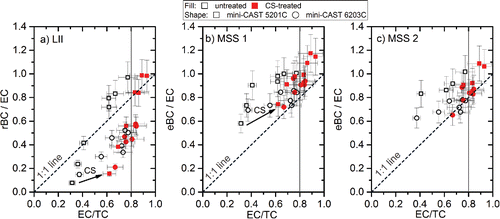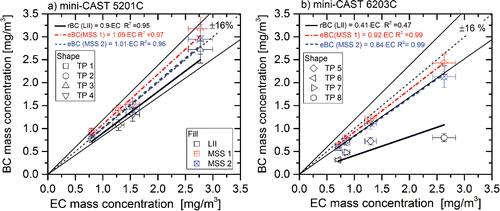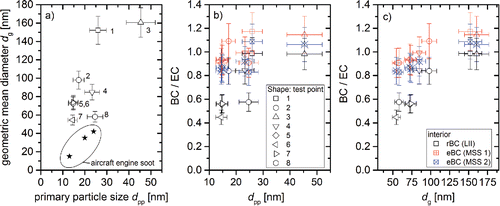Figures & data
Figure 2. Ratios of the real-time BC to filter EC as a function of the EC/TC for the LII (a), MSS 1 (b), and MSS 2 (c). Error bars represent the propagated errors in the BC and EC mass concentrations. We assumed 10% error for BC mass concentration measurement and the average error in the EC mass concentration was 8%. MSS 2 data were not logged at all test conditions.

Table 1. Summary of the mini-CAST settings, EC/TC, dg, and dpp for the eight selected test points with the highest EC/TC using the CS.
Figure 3. Comparison of the real-time BC (DF 2 corrected) with the filter EC for EC/TC > 0.8 for test points 1–4 generated by the mini-CAST 5201C (a) and test points 5–8 generated by the mini-CAST 6203C (b).

Figure 4. Effective density distributions for test points 1–4 generated by the mini-CAST 5201C (a) and test points 5–8 generated by the mini-CAST 6203C (b). Error bars represent the assumed errors of 10% for effective density and 3% for particle size measurement. The gray areas show the range of effective density distributions found for aircraft turbine engines using the same technique (Durdina et al. Citation2014; Lobo et al. Citation2015).

Figure 5. TEM images of soot particles. Circles represent the estimated primary particle diameter from DMA-CPMA measurements and the DLCA theory.

Figure 6. Geometric mean diameter as a function of primary particle size compared for mini-CAST test points 1–8 and aircraft engine soot (Durdina et al. Citation2014; Liati et al. Citation2014) (a); BC/EC response as a function of the primary particle size (b) and the geometric mean diameter (c).



